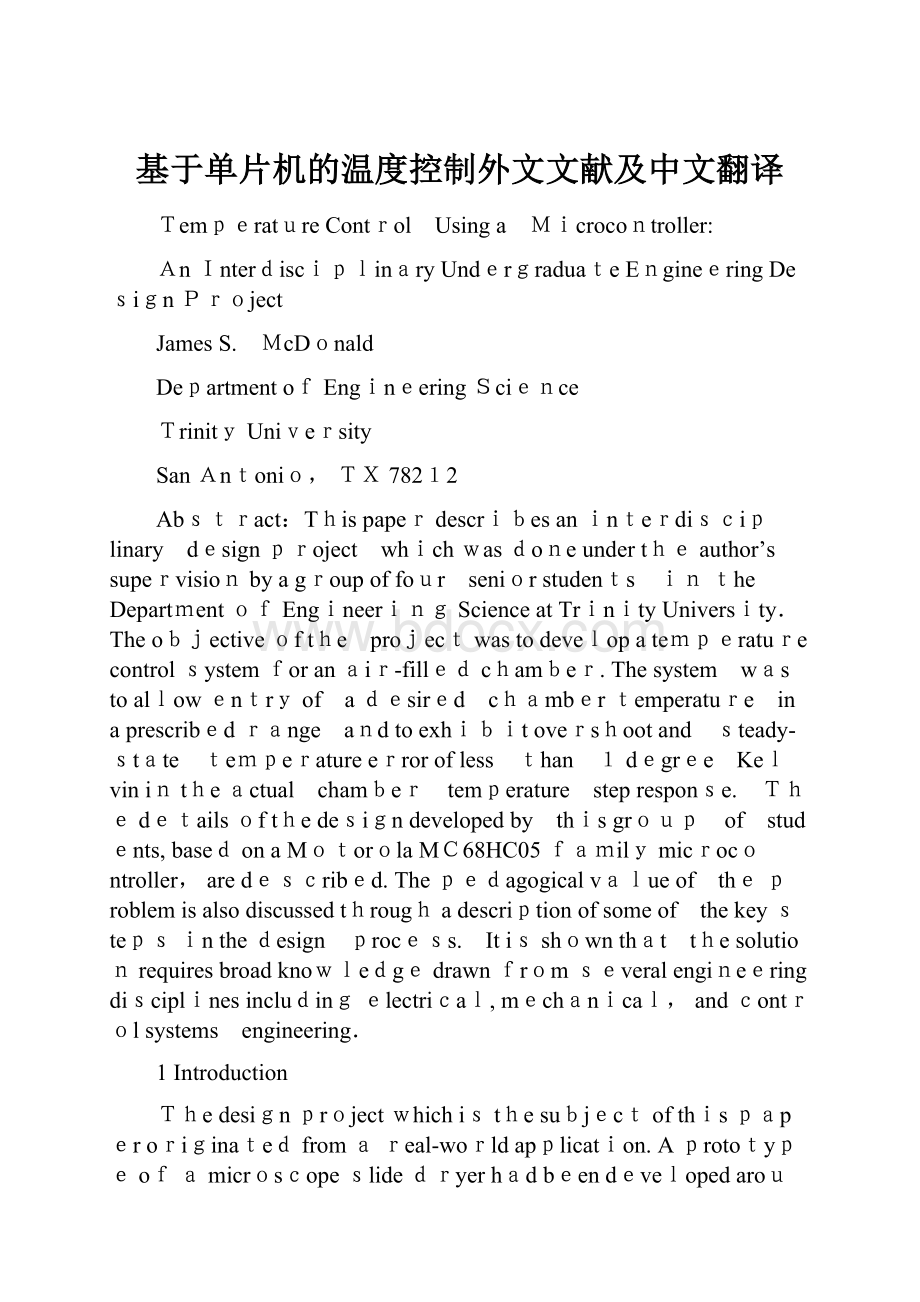 基于单片机的温度控制外文文献及中文翻译.docx
基于单片机的温度控制外文文献及中文翻译.docx
- 文档编号:9193619
- 上传时间:2023-02-03
- 格式:DOCX
- 页数:23
- 大小:431.87KB
基于单片机的温度控制外文文献及中文翻译.docx
《基于单片机的温度控制外文文献及中文翻译.docx》由会员分享,可在线阅读,更多相关《基于单片机的温度控制外文文献及中文翻译.docx(23页珍藏版)》请在冰豆网上搜索。

基于单片机的温度控制外文文献及中文翻译
TemperatureControl Usinga Microcontroller:
AnInterdisciplinaryUndergraduateEngineeringDesignProject
JamesS. McDonald
DepartmentofEngineeringScience
TrinityUniversity
SanAntonio,TX78212
Abstract:
Thispaperdescribesaninterdisciplinary designproject whichwasdoneundertheauthor’s supervisionbyagroupoffour seniorstudents intheDepartmentofEngineeringScienceatTrinityUniversity.Theobjectiveofthe projectwastodevelopatemperature controlsystemforanair-filledchamber.Thesystem was toallowentryof adesired chambertemperature inaprescribedrange andtoexhibitovershootand steady-state temperatureerrorofless than 1degree Kelvinintheactual chamber temperature stepresponse. Thedetailsofthedesigndevelopedby thisgroup of students,basedonaMotorolaMC68HC05familymicrocontroller,aredescribed.Thepedagogicalvalueof theproblemisalsodiscussedthroughadescriptionofsomeof thekeystepsinthedesign process. Itisshownthat thesolutionrequiresbroadknowledgedrawnfromseveralengineeringdisciplinesincludingelectrical,mechanical,andcontrolsystems engineering.
1Introduction
Thedesignprojectwhichisthesubjectofthispaperoriginatedfromareal-worldapplication.Aprototypeofamicroscopeslidedryerhadbeendevelopedaround an OmegaTMmodelCN-390temperaturecontroller,andtheobjectivewastodevelopa custom temperature controlsystemtoreplacetheOmegasystem.Themotivation wasthata customcontrollertargeted specificallyforthe application shouldbeable toachievethe samefunctionality ata much lower cost, astheOmegasystemisunnecessarilyversatileandequippedtohandleawidevariety ofapplications.
Themechanicallayoutoftheslidedryerprototypeis showninFigure1. Themainelementofthedryeris alarge, insulated,air-filledchamberinwhich microscopeslides,eachwitha tissuesample encasedin paraffin,canbesetoncaddies.In orderthat theparaffinmaintaintheproper consistency,thetemperaturein theslide chambermustbemaintainedat a desired(constant)temperature.A secondchamber(theelectronicsenclosure)housesaresistiveheater and thetemperaturecontroller,and a fan mountedon theendofthedryerblowsairacrosstheheater,carryingheatintotheslide chamber. Thisdesignproject wascarriedoutduringacademicyear1996–97byfourstudentsundertheauthor’ssupervision asa SeniorDesignproject in theDepartmentof EngineeringScienceatTrinityUniversity.Thepurposeofthispaperis
todescribe theproblemandthestudents’ solutionin somedetail,andtodiscuss someofthepedagogicalopportunitiesoffered byan interdisciplinarydesignprojectof this type.Thestudents’ ownreportwaspresentedat the1997 NationalConferenceonUndergraduateResearch[1]. Section2 givesamoredetailedstatementof the problem,includingperformance specifications,andSection 3describesthestudents’design.Section4makesupthebulkofthepaper,anddiscussesinsome detailseveral aspectsof thedesignprocesswhichofferuniquepedagogical opportunities.Finally,Section5offerssomeconclusions.
2Problem Statement
Thebasic ideaoftheprojectistoreplace therelevantpartsofthefunctionality of anOmegaCN-390temperature controllerusingacustom-designedsystem.The applicationdictates thattemperaturesettingsareusually keptconstantforlong periodsoftime,but it’s nonetheless importantthatstepchangesbetrackedina“reasonable”manner.Thusthemainrequirementsboil downto
·allowinga chambertemperatureset-pointto be entered,
·displayingbothset-pointandactualtemperatures,and
·trackingstepchangesin set-pointtemperature withacceptablerise time,steady-stateerror,andovershoot.
Although notexplicitlyapart of thespecificationsinTable1,itwasclearthatthecustomerdesireddigital displaysofset-pointandactual temperatures,andthat set-point temperatureentryshould bedigital aswell(asopposedto, say,through apotentiometersetting).
3System Design
Therequirementsfordigitaltemperaturedisplaysandsetpointentryaloneareenoughtodictate that amicrocontrollerbased designis likelythemost appropriate. Figure 2shows ablock diagramofthestudents’design.
Themicrocontroller,aMotorolaMC68HC705B16(6805for short),isthe heart ofthesystem.Itaccepts inputsfroma simplefour-key keypadwhichallowspecification of theset-pointtemperature,anditdisplaysbothset-pointand measuredchambertemperaturesusingtwo-digit seven-segmentLED displays controlledbyadisplaydriver.Alltheseinputsandoutputsare accommodatedbyparallelports onthe6805.Chamber temperatureis sensedusingapre-calibratedthermistorandinputviaone ofthe6805’sanalog-to-digitalinputs.Finally,apulse-width modulation(PWM)outputonthe6805isused todrivearelaywhichswitches linepower totheresistive heateroffandon.
Figure3showsamoredetailedschematicoftheelectronicsandtheirinterfacing to the 6805.Thekeypad,aStorm3K041103,has fourkeys whichareinterfacedto pinsPA0{ PA3of Port A,configuredasinputs. Onekeyfunctionsas amodeswitch. Twomodesare supported:
setmode andrun mode.Insetmode twoof theotherkeys areusedtospecifythe set-point temperature:
oneincrementsitandone decrements. Thefourthkeyis unused atpresent.TheLEDdisplaysare drivenbyaHarrisSemiconductorICM7212display driver interfacedtopinsPB0{PB6ofPortB, configuredasoutputs.Thetemperature-sensingthermistordrives,throughavoltagedivider,pinAN0(oneofeight analoginputs). Finally,pinPLMA(one oftwo PWMoutputs) drivestheheaterrelay.
Softwareonthe6805implementsthetemperaturecontrol algorithm,maintainsthetemperature displays,andalterstheset-pointinresponse to keypadinputs.Because it is notcompleteatthis writing,softwarewillnot bediscussedindetail inthispaper.Thecontrolalgorithminparticularhas notbeen determined,butitis likelytobeasimple proportionalcontrollerand certainlynotmore complex thanaPID.Somecontroldesignissues willbediscussedinSection 4,however.
4TheDesignProcess
Althoughessentiallytheprojectisjusttobuilda thermostat,itpresentsmany nicepedagogicalopportunities. Theknowledgeandexperiencebase ofaseniorengineeringundergraduateare justenoughto bring himorher tothe brinkofasolutiontovariousaspectsofthe problem.Yet, in eachcase,realworldconsiderationscomplicatethe situationsignificantly.
Fortunatelythesecomplicationsarenotinsurmountable,andtheresultisa verybeneficialdesignexperience.The remainder of thissection looks ata fewaspectsof theproblemwhichpresentthetype oflearning opportunityjust described.Section 4.1discussessomeofthefeaturesofa simplified mathematicalmodelofthe thermalproperties of thesystemandhowitcan beeasilyvalidatedexperimentally.Section 4.2describeshowrealisticcontrolalgorithm designscanbearrivedatusingintroductoryconceptsincontroldesign.Section 4.3points outsomeimportant deficienciesofsucha simplifiedmodeling/controldesignprocess andhowtheycan beovercomethroughsimulation.Finally,Section4.4givesanoverviewofsomeof the microcontroller-relateddesignissues whichariseandlearningopportunities offered.
4.1MathematicalModel
Lumped-elementthermal systems aredescribedinalmost anyintroductory linearcontrol systemstext,and justthissort ofmodelisapplicableto theslide dryerproblem. Figure4shows asecond-orderlumped-elementthermalmodeloftheslidedryer.The state variablesarethe temperaturesTaof the air inthe box andTbofthe boxitself.Theinputstothe system arethepoweroutputq(t)oftheheaterandthe ambienttemperatureT¥. maandmbarethemasses ofthe airand thebox,respectively,and CaandCbtheirspecificheats.μ1 andμ2areheattransfer coefficientsfromtheairtothe boxandfrom theboxtotheexternal world,respectively.
It’snothardtoshowthatthe(linearized)stateequationscorresponding toFigure4are
TakingLaplacetransformsof
(1)and
(2)andsolvingfor Ta(s), which isthe outputofinterest,gives thefollowingopen-loop model ofthethermal system:
whereKisaconstantandD(s) isasecond-orderpolynomial.K,tz,and thecoefficientsofD(s)arefunctionsofthevariousparameters appearingin
(1) and
(2).Ofcoursethe variousparametersin
(1)and(2)are completelyunknown,but it’snot hardtoshow that,regardlessoftheirvalues,D(s)hastworealzeros.Thereforethemaintransferfunctionofinterest(whichistheone from Q(s),sincewe’llassume constant ambienttemperature) canbe written
Moreover, it’snottoohardtoshowthat1=tp1 <1=tz <1=tp2,i.e.,that thezeroliesbetweenthetwopoles.Bothoftheseareexcellentexercisesfor the student, and the resultistheopenlooppole-zero diagramofFigure 5.
Obtaining acompletethermalmodel,then,isreduced toidentifyingtheconstant Kandthethreeunknowntimeconstantsin(3). Fourunknownparametersisquiteafew,butsimpleexperiments show that1=tp1_1=tz;1=tp2 so thattz;tp2_ 0aregood approximations.Thustheopen-loopsystemisessentially first-order andcanthereforebewritten
(where thesubscriptp1has beendropped).
Simpleopen-loopstep responseexperimentsshowthat,forawiderange ofinitialtemperaturesandheatinputs,K_0:
14 _=W andt_295s.1
4.2Control SystemDesign
Usingthefirst-order modelof(4) fortheopen-loop transfer function Gaq(s)andassumingforthemomentthatlinearcontroloftheheaterpower outputq(t)ispossible, the blockdiagramofFigure6representstheclosed-loopsystem.Td(s)isthedesired,or set-p
- 配套讲稿:
如PPT文件的首页显示word图标,表示该PPT已包含配套word讲稿。双击word图标可打开word文档。
- 特殊限制:
部分文档作品中含有的国旗、国徽等图片,仅作为作品整体效果示例展示,禁止商用。设计者仅对作品中独创性部分享有著作权。
- 关 键 词:
- 基于 单片机 温度 控制 外文 文献 中文翻译
 冰豆网所有资源均是用户自行上传分享,仅供网友学习交流,未经上传用户书面授权,请勿作他用。
冰豆网所有资源均是用户自行上传分享,仅供网友学习交流,未经上传用户书面授权,请勿作他用。


 1212中级汽车维修工考试试题三.docx
1212中级汽车维修工考试试题三.docx
